This easy Italian Bread Salad or Panzanella is the perfect deliciously budget-friendly, refreshing salad to enjoy on spring and summery days. This Italian salad is naturally plant-based and vegan and its other name is Poor Mans Salad! Old-fashioned Italian recipes are packed with humble ingredients that can be elevated with a few simple ingredients, and as such are incredibly versatile, and if you don't have a certain ingredient? It doesn't matter as it can be easily omitted or substituted for something else.
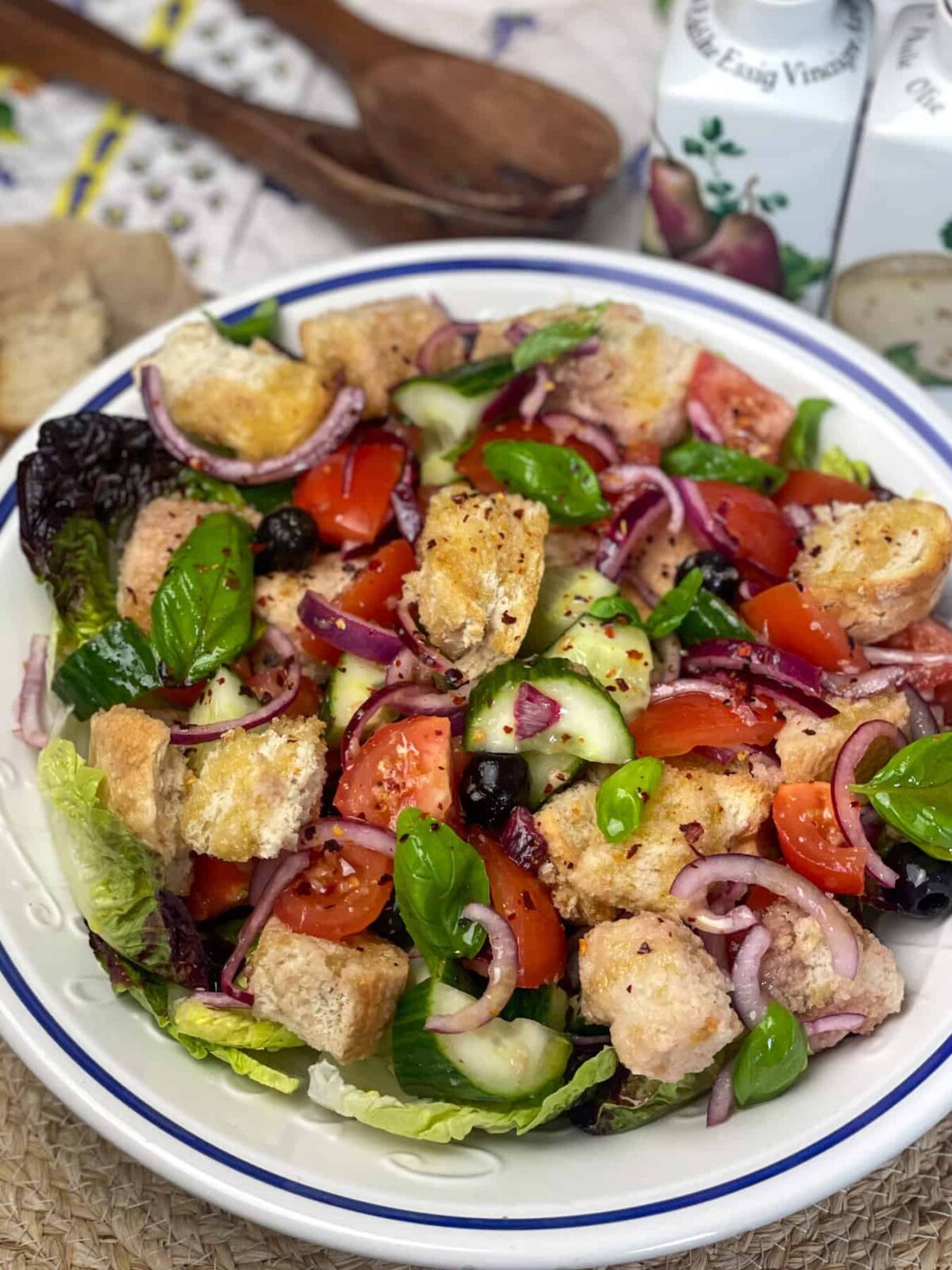
Hailing from Tuscany and other Italian regions, this salad was originally referred to as a Poor Mans Salad or an Italian Peasant Salad. Panzanella is simply stale or toasted bread soaked in vinegar before being tossed with whatever fresh salad ingredients were available. This humble meal is perfect for using up leftover bread or reduced bread by transforming it into a refreshingly special meal.
The history of Panzanella or Italian Poor Mans salad
Panzanella is a traditional Italian salad that primarily features stale bread and fresh veggies. Its origins can be traced back to the region of Tuscany in Italy, although variations of the dish are now popular throughout the country.
The history of Panzanella dates back to the Middle Ages when it was common for Italian peasants to use stale bread as a base for their meals to avoid wasting food. The earliest versions of Panzanella did not include tomatoes, as tomatoes were not introduced to Italy until after the Columbian Exchange in the late 15th and early 16th centuries.
Instead, the original Panzanella was likely a simple dish consisting of hard, stale bread mixed with vegetables like onions and cucumbers. The stale bread was prepared by soaking it in water and then squeezing the bread to remove the excess moisture. If the salad was given a dressing it would likely have been a simple sprinkle of vinegar and possibly a drizzle of olive oil.
After tomatoes were introduced to Italy, they were incorporated into the Panzanella salad. Today, a classic Panzanella includes stale bread either soaked in red wine vinegar and then squeezed, or the bread toasted into croutons, along with ripe tomatoes, onions, cucumbers, fresh basil, olive oil, and vinegar. Some variations might also include ingredients like olives, capers, or mozzarella cheese.
Panzanella is particularly popular in the summer months when tomatoes are at their peak juicy ripeness. It's a great example of Italian "cucina povera," or "peasant cooking," which emphasizes simplicity, seasonality, and making use of what's on hand.
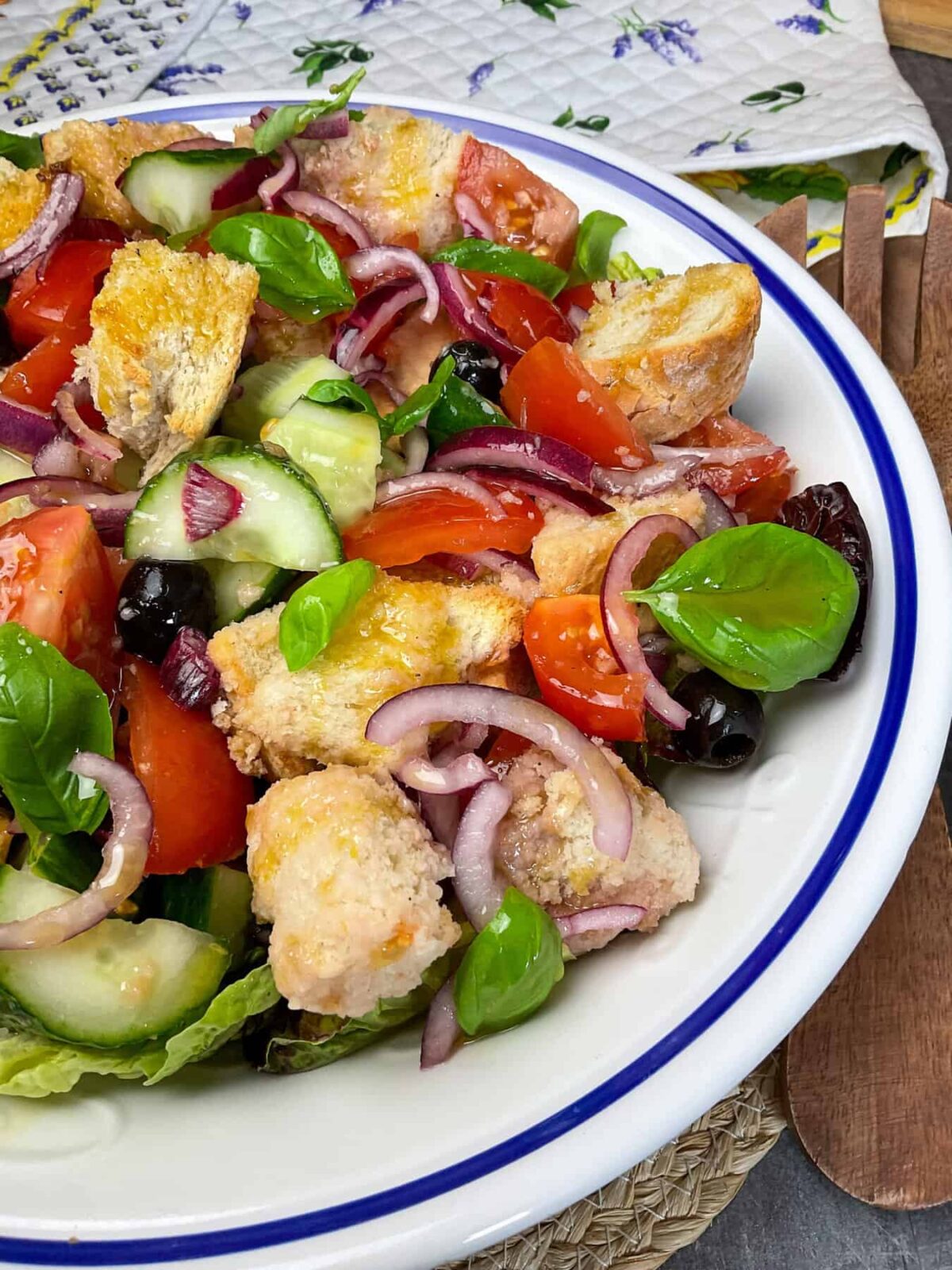
A big bowl of Panzanella salad would be the ideal accompaniment to a barbeque or cook-out. My daughter loves a bowl of this bread salad as a gardening snack, she perches amongst her plants and grass clippings [she's not keen on garden chairs!] happily munching a bowl of this tasty salad which I pass through to her via our living window!
Medieval Italian peasants ate mostly a plant-based diet
Even though Panzanella dates back to medieval times and was prepared with plant-based ingredients, medieval Italian peasants was not actually intentionally vegan, but many dishes could be considered "accidentally vegan" because they were based on plant foods. This was due primarily to lack of financial means. Meat was expensive and often reserved for the wealthy or for special occasions. Dairy products, while more accessible, were also not consumed in large quantities.
The bulk of the peasant diet was made up of grains (like wheat, barley, and millet), legumes (like lentils and chickpeas), vegetables (like cabbage, onions, and leeks), and when available fruits. Olive oil was the primary cooking fat in the Mediterranean regions, while lard was more common in the north.
However, it's important to note that eggs, cheese, and small amounts of meat or fish (when available) were also part of the medieval peasant diet. However, many traditional Italian dishes that are now served with cheese or a meat-based sauce were originally plain vegetable or bean dishes.
Also, the concept of veganism as we know it today, which includes an ethical commitment to avoid all animal products, did not really exist in medieval times. People ate what they could afford and what was available to them otherwise they would likely starve.
Also, the Great Famine of 1315-1317, also known as The Great European Famine, affected many parts of Europe, as well as Italy, and many perished to hunger and death. The Great Famine was caused in part by crop failures, adverse weather conditions especially heavy rains, cattle and sheep disease epidemics, and local political wars which led to trade route disruptions and social unrest!
So it was all go during those turbulent years, and nothing could be wasted especially inexpensive bread, and peasants had to eat whatever they could get their hands on.
How to prepare easy Panzanella
There are a few easy steps to preparing this Panzanella but all are relatively quick and fuss free. Also, there is no need to use stale bread but of course if you do have stale bread then use it up for this recipe.
First the bread is briefly marinated before being toasted, and then the red onions are given a quick simple pickle, next an easy salad dressing is prepared, before everything is tossed together into a delicious mish-mash of tastiness!
Alternatively, skip the toasting of the bread cubes and just use them as they are. I've tried both ways and each way is equally delicious.
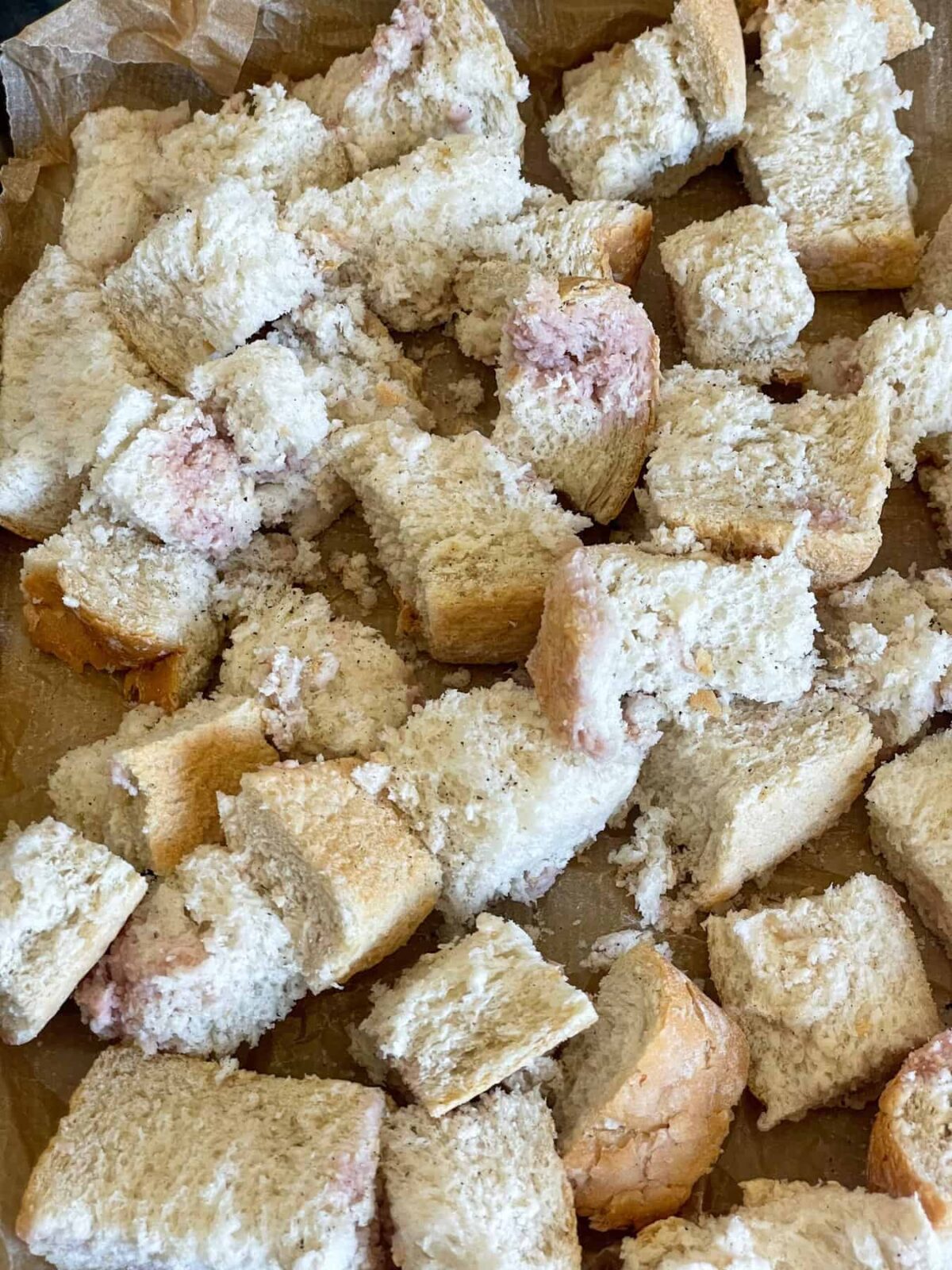
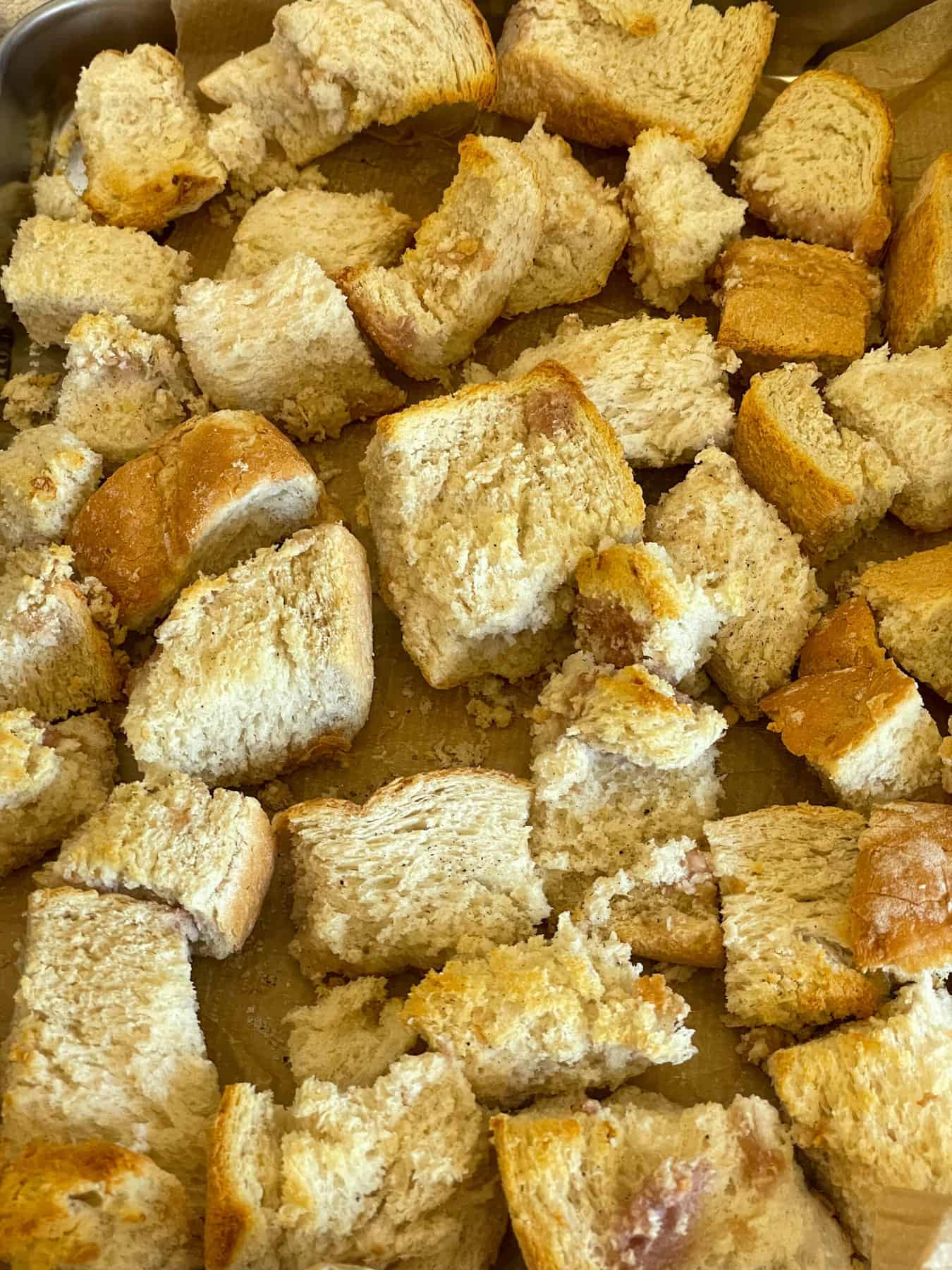
First tear or chop the crusty bread into rough bite-size cube shapes and place into a bowl, sprinkle the red wine vinegar [can replace with balsamic vinegar] over, stir the bread around so that the vinegar coats the bread, and leave to marinate for a few minutes.
[This stage can be done in advance and the bread left for a few hours or until the next day.]
To toast the bread cubes, bake in the oven for 10 minutes, turning the cubes half way through cooking.
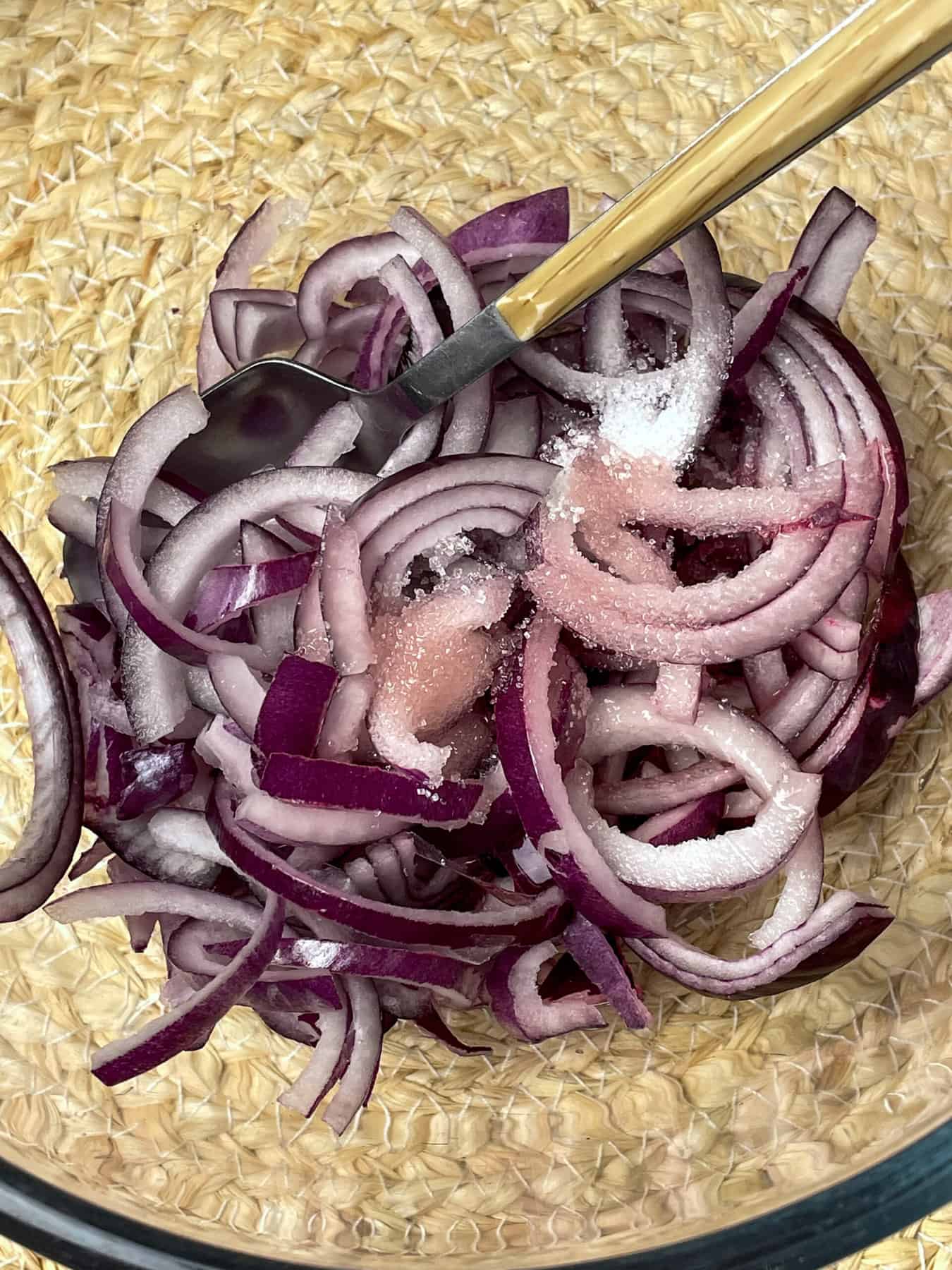
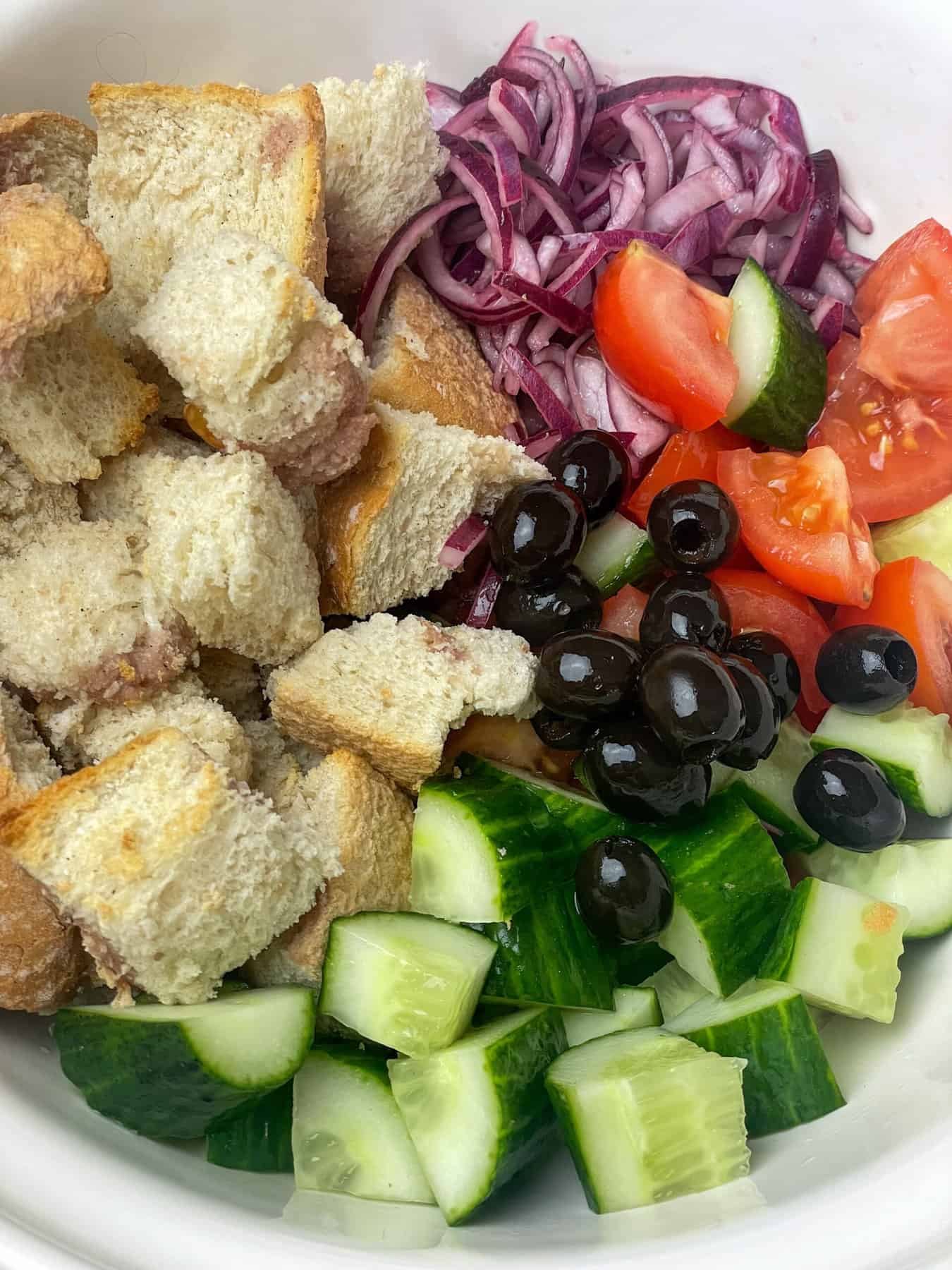
While the bread is toasting, prepare the quick red onion pickle. Place the thin onion rings into a small dish and sprinkle the sugar and vinegar over.
Stir well and leave for about 5 minutes before adding to the salad.
Prepare the salad dressing by mixing the olive oil, red wine vinegar, sugar and a few pinches of salt and pepper to a small bowl, and stir well.
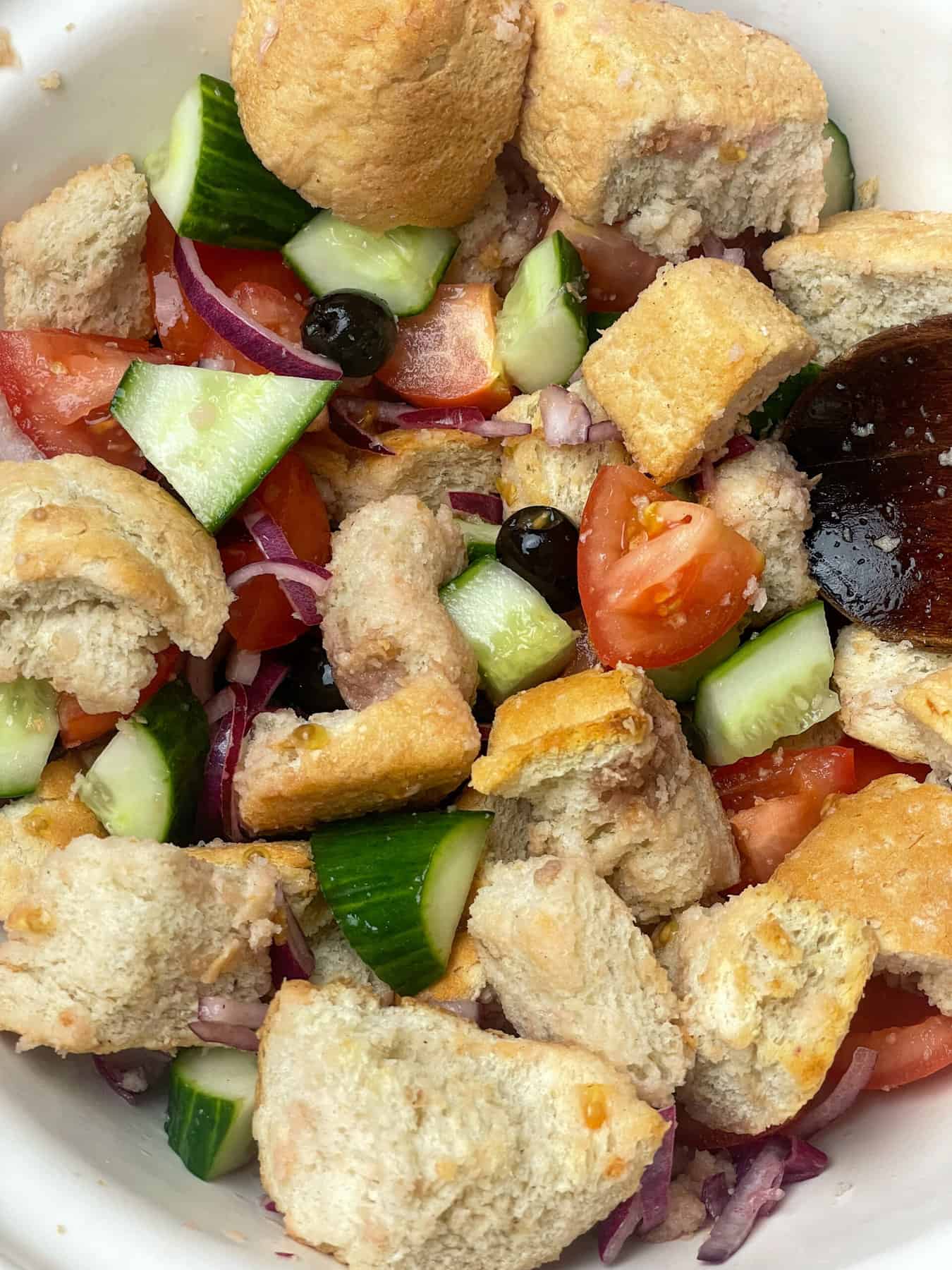
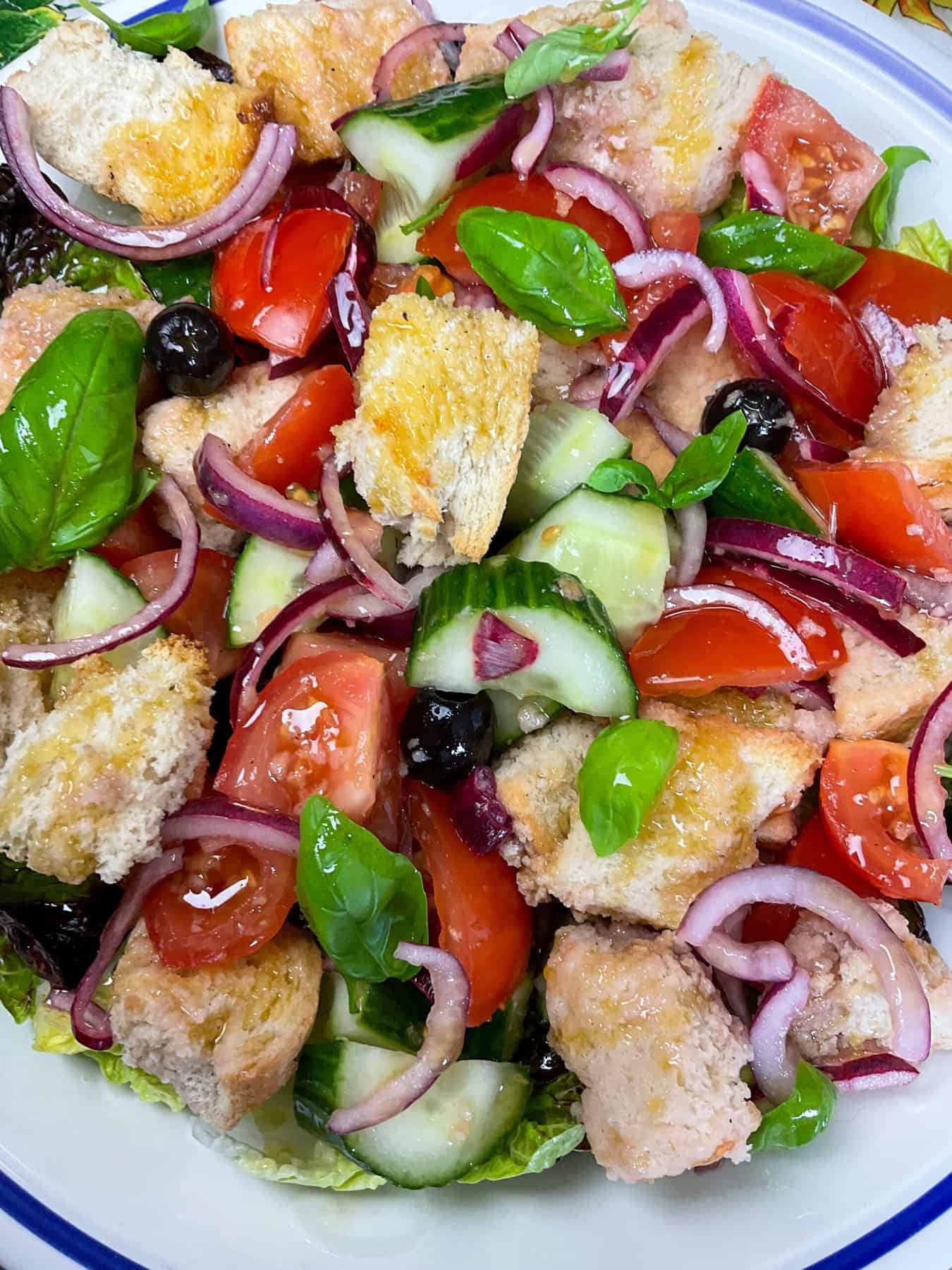
To assemble the salad, add the lettuce, chopped cucumber, tomatoes, pickled red onion, some of the basil leaves, and olives if using, to a salad bowl along with the toasted bread cubes.
Pour the salad dressing over the the salad and toss everything together.
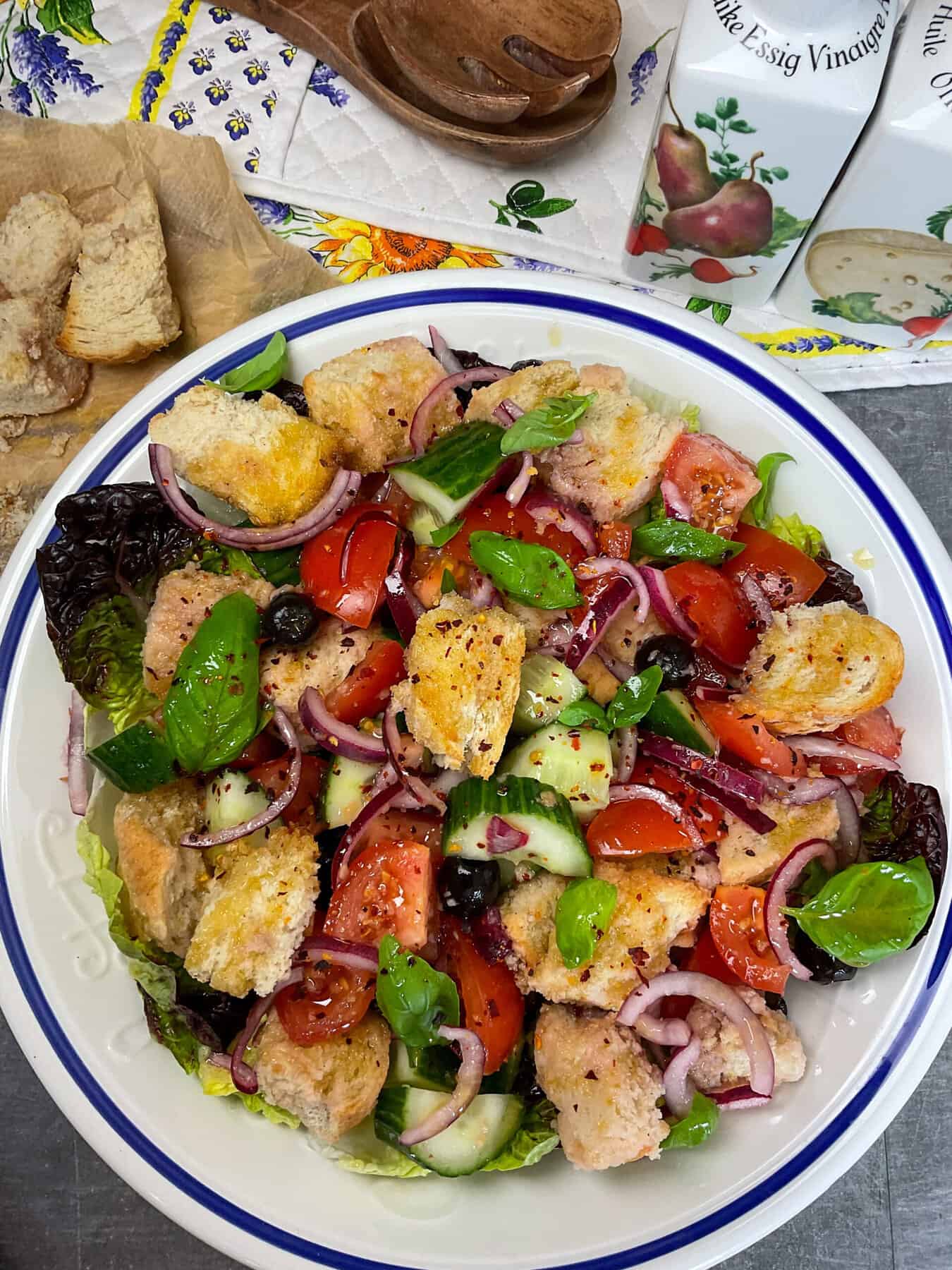
Scatter the rest of the basil leaves over the salad and it good to go. A few red pepper or paprika flakes are a nice optional touch.
Recipe notes and frequently asked questions
Storage
Panzanella is best eaten fresh, as the bread can become overly soggy if left to sit for too long, but the bread is still tasty as it simply soaks up the flavours. If you have leftovers or want to prepare it in advance, there are ways to store it.
- Store the components separately: If you know in advance that you won't be consuming all of the salad at once, it's best to store the components separately. Keep the bread cubes, vegetables, red onion pickle, and dressing in separate airtight containers in the fridge. When you're ready to eat, simply mix them together. The bread cubes can be stored at room temperature if they're fully dried out; otherwise, store them in the fridge.
- Refrigerate leftovers: If you've already mixed the salad, you can store leftovers in an airtight container in the fridge for 1-2 days. The bread will continue to absorb the dressing and flavours, which some people actually prefer.
Remember, Panzanella is a dish that's designed to use up stale bread, so a little sogginess is part of its charm!
Traditional Panzanella is not gluten-free, as it is made with stale bread, which typically contains wheat. However, Panzanella can be easily adapted to be gluten-free by using gluten-free bread in place of wheat bread.
Red wine vinegar is generally considered gluten-free as it is made from fermenting red wine, and the fermentation process removes the gluten proteins, which are found in grains like wheat, barley, and rye.
However, some brands of red wine vinegar may add additional ingredients that could contain gluten so just your bottle to make sure.
Yes, as Panzanella is a budget-friendly meal then do tailor the ingredients to what ingredients you already have, if you think they would be a good substitute. Here are a few useful suggestions:
Crusty Bread: Of course Panzanella is a bread salad so the bread is not really replaceable, but its your salad dish, so if you would like an alternative, I would think these Crispy Tofu Bites would work well as a bread substitute and they will not require further toasting so just use the crispy tofu as it is.
Red Wine Vinegar: If you prefer a different type of vinegar or don't have red wine vinegar on hand, you can substitute it with other vinegars such as white wine vinegar, apple cider vinegar, or balsamic vinegar. Although a different vinegar may change the flavour of the salad.
Cucumber: Feel free to substitute the cucumber with other crunchy vegetables like bell peppers, grated carrot, zucchini [courgette]. You can also try using radishes for a different texture and spicier flavour.
Tomatoes: While tomatoes are a classic ingredient in a relatively modern Panzanella, and any type of tomatoes are fine, if fresh tomatoes are not available, you can try using sun-dried tomatoes for a stronger flavour. Or replace the tomatoes with grapes, surprisingly grapes are a tasty salad ingredient as our Traditional Waldorf Salad recipe will testify!
Lettuce: Use any variety of lettuce such as ice-berg, romaine, little gems, rocket [arugula], spinach, watercress, baby chard, young beetroot leaves, or mixed salad leaves. Clean dandelion leaves can also be used and the bonus is that they can be foraged for free!
Quick Pickled Red Onion: If you prefer not to use refined sugar, you can substitute it with alternative sweeteners like maple syrup, agave syrup, or date syrup or your usual sugar.
Salad Dressing: Replace this with your favourite salad dressing or even a vegan shop-bought salad dressing.
Olives: If you're not a fan of olives, you can substitute them with capers or grapes or omit them altogether. Alternatively, if you do omit the olives chuck in a few more tomatoes to compensate.
Basil Leaves: If you don't have basil leaves, you can switch them out with other fresh herbs like parsley, coriander [cilantro], chives or spring onions which are also known as scallions.
Lots of different vegetables are delicious when given a quick pickle and added to a salad. They provide interesting and tasty crunch, tanginess and sweetness.
While red onion is a good choice for quick pickling, you can use various other vegetables to create quick pickles for your Panzanella or indeed any other salad or even as a sandwich filling:
Here are a few suggestions:
Cucumber: Slice or dice cucumbers and pickle them using the same method as the red onions.
Carrots: Slice carrots into thin rounds or julienne them for a different texture.
Carrot pickles can add a touch of sweetness and vibrant color to your salad.
Radishes: Thinly slice or quarter radishes to create tangy and colorful pickles. They provide a peppery spicy kick.
Bell Peppers: Slice bell peppers into thin strips or rings and pickle them.
Beets: Slice or cube beets and pickle them for a vibrant and earthy addition to your Panzanella.
Green Beans: Use fresh green beans and pickle them for a crisp and slightly tangy element.
When pickling alternative vegetables, use the same method as for pickling the red onion, although you may have to adjust the sugar and vinegar quantities if you use a larger amount of vegetables, larger vegetables, and to suit your personal taste. Your home-made vinegar will be fine stored within the refrigerator for 2-3 days, but do keep it in a covered container.
Yes of course. Panzanella can be customized with the addition of protein such as these Crispy Tofu Bites, roast chickpeas croutons, white beans, or cooked quinoa or your own choice. If you have any leftover cooked vegan sausages, burgers or similar, then these can be chopped up and tossed through the salad.
Yes, anything you like! A few ideas:
Roasted Vegetables: Add roasted vegetables like bell peppers, courgettes, aubergines, mushrooms, or tomatoes for an interesting texture contrast.
Avocado: Slice or dice ripe avocado and toss it with the other ingredients.
Nuts or Seeds: Sprinkle toasted pine nuts, or walnuts, hazelnuts, flaked almonds, peanuts, sunflower seeds, or pumpkin seeds.
Vegan Cheese: If liked, crumble some vegan cheese over the Panzanella salad for a savory and cheesy element. Cubes of vegan feta, vegan mozzarella, or grated vegan Parmesan are good options.
Fruit: For a touch of sweetness add fruit like strawberries, peaches, apples, orange segments, or grapes to the Panzanella.
Yes, Panzanella was developed as a budget-friendly meal. It originated as a way for Italian peasants to use up stale bread, making the most of what they had to hand. The main components of Panzanella are:
Stale bread: This is a way to use up leftover bread that's past its prime, so it doesn't require buying a new loaf specifically for the dish.
Tomatoes: These are typically the main vegetable component, but you can use whatever tomatoes are in season and well-priced. In fact, you can adapt the recipe to include other inexpensive, in-season vegetables.
Onion and Cucumber: These are traditional ingredients in Panzanella and are generally less expensive compared to other salad ingredients.
Vinegar and Olive Oil: These form the dressing for Panzanella. While olive oil can be a bit expensive, a little goes a long way, and it's a staple that can be used in many different dishes. Any vinegar you have to hand can be used especially apple cider vinegar, balsamic, white wine vinegar, but if all you have is ordinary white distilled then simply use that.
Basil: While fresh basil adds a wonderful flavor to the dish, you can substitute it with other more affordable or available herbs, or even omit it if necessary.
Remember, the beauty of Panzanella is its flexibility. The recipe can be adapted based on what you have on hand, making it a great option for a budget-friendly, waste-reducing meal.
Of course not. You can make an oil-free Panzanella salad by simply omitting the oil.
Here are a few oil substitutions, but do bear in mind that the overall flavour and texture of the Panzanella will be different from the original recipe, and you may need to adjust the quantities of the new ingredient as well as the other dressing ingredients to achieve the flavour and texture that you prefer:
Avocado: Substitute the olive oil with mashed avocado. Avocado provides a creamy texture and healthy fats that can help emulsify the dressing. Use ripe avocado and adjust the quantity to achieve the desired consistency. Look out for reduced price avocados as these are perfect for salad dressings.
Nut or Seed Butter: Add richness to the dressing by incorporating a spoonful of nut or seed butter such as peanut butter, almond butter, cashew butter, sunflower seed butter, or tahini (sesame seed paste). These options provide a creamy texture and a hint of nutty flavor.
Plant-Based Yogurt: Use unsweetened and plain plant-based yogurt, such as almond, soy, or coconut yogurt, as a base for the dressing. It adds creaminess and tanginess to the dressing.
Mustard: Add a dollop of Dijon mustard or whole grain mustard to the dressing. Mustard acts as an emulsifier and provides a tangy flavour that complements the other ingredients.
Citrus Juice: Citrus juice, such as lime or lemon juice, add brightness and acidity to the dressing, enhancing the flavours of the salad. You may need less citrus juice compared to the amount of oil required in the dressing recipe, so experiment a little to get the balance of flavours to your liking.
It depends on the individual bread as shop-bought bread can vary in ingredients, so it's important to check the packaging to ensure they are vegan. In general, many varieties of bread, such as plain white, whole wheat or wholemeal, sourdough, or multigrain bread, are typically vegan-friendly as they usually just consist of flour, water, yeast, and often additional ingredients like salt and sugar.
However, some shop-bought bread products may contain non-vegan ingredients such as honey, milk, eggs, margarine with animal ingredients, or butter. These ingredients are often used for flavour, texture, or as preservatives.
The other ingredient to look out for is L-cysteine or E920 which is an amino acid that is used to condition the bread dough and help the bread last longer, and it usually is made from animal sources such as poultry feathers or even human hair!
Thankfully, many common breads available in shops and stores do tend to label their breads as vegan so look for the vegan logo to be certain the bread is fine for vegan and plant-based diets.
When making Panzanella, it's best to use a bread that can hold its texture when mixed with the dressing and salad veggies. Ultimately, you can use any bread for Panzanella as this recipe includes toasting the bread which helps maintain its texture but here are some bread choices that work particularly well:
Rustic Italian Bread: Traditional Panzanella is made with crusty Italian bread, such as ciabatta or Tuscan bread. These breads have a chewy texture and absorb the dressing nicely.
Baguette: A classic French baguette can also be used for Panzanella.
Sourdough Bread: Sourdough bread adds a tangy flavor and a chewy texture to Panzanella.
Day-Old or Stale Bread: Panzanella is a great way to use up leftover or day-old bread. If you have a slightly stale loaf of bread, it can work perfectly for this salad. Stale bread will absorb the dressing well without becoming mushy.
Budget-Friendly Bread: If you're looking for more budget-friendly options, consider store-brand bread or bread from the bakery's day-old section. These options can often be more affordable and will make a perfectly tasty Panzanella.
Of course, for vegan and plant-based diets ensure that the bread you choose is vegan-friendly, and for gluten-free diets select a gluten-free bread.
Yes absolutely. In todays cost of living crisis and rising energy costs you may prefer to avoid using the oven especially if its just for small bakes like toasting bread cubes. If so, below is an easy guide to toasting bread cubes in an air-fryer.
However, its not necessary to toast the bread cubes for your Panzanella salad so if you'd prefer to skip this step that's perfectly fine. I've did both ways and enjoy toasted and not toasted, so go with whatever you prefer.
Preheat the Air Fryer: Set your air fryer to the desired temperature. Around 350°F (175°C) is typically suitable for toasting bread cubes.
Toss the Bread Cubes: In a bowl, toss the bread cubes with a few tablespoons of red wine vinegar until they are evenly coated. Allow the bread cubes to absorb the vinegar for a few minutes.
Arrange the Bread Cubes in the Air Fryer: Place the bread cubes in the air fryer basket or tray. Avoid overcrowding to ensure even toasting, however if you do have more than a layer of bread cubes then just shake the basket more during toasting so that the bread pieces at the bottom get a chance to toast.
Toast in the Air Fryer: Insert the basket or tray into the air fryer and cook the bread cubes for approximately 5 to 7 minutes, or until they are golden brown and crispy. Monitor the toasting process closely to prevent burning, as the exact cooking time may vary depending on your air fryer model.
Shake and Flip: After a few minutes of toasting, gently shake the air fryer basket or flip the bread cubes with tongs to ensure even browning on all sides. This helps to achieve a uniform texture and prevents any burnt spots.
Check for Desired Crispiness: Keep an eye on the bread cubes and check their crispiness. If they need additional toasting, you can continue cooking them in the air fryer for a few more minutes, checking frequently until they reach your preferred level of crunch. Smaller bread cubes will toast quicker so do keep your eye on them and check every few minutes to see how they are going.
Cool and Use in Panzanella: Once the bread cubes are toasted and crispy, remove them from the air fryer and let them cool before mixing them into your Panzanella salad.
Note: Adjust the cooking time and temperature as needed based on your air fryer's settings, the size of your bread cubes, the type of bread you are using, and the desired level of toastiness. Enjoy!
Cool Completely: Allow the toasted bread cubes to cool completely before storing them. This helps to prevent moisture buildup and maintain their crispness.
Use an Airtight Container: Transfer the cooled bread cubes to an airtight container. Make sure the container is clean and dry before adding the bread cubes.
Avoid Excess Moisture: Moisture can make the bread cubes lose their crunch. Ensure that the container is completely dry and there are no moisture sources nearby when storing the toasted cubes.
Don't Mix with Moist Ingredients: If you plan to store the toasted bread cubes with other salad ingredients, such as vegetables or dressing, it's best to keep them separate until ready to serve. Combining them too early can lead to the bread cubes becoming soggy. However, with leftover Panzanella sometimes the charm is the soggy bread cubes! As they simply soak up the tasty Italy flavours.
Store at Room Temperature: Keep the container of toasted bread cubes at room temperature. Avoid storing them in the refrigerator, as the moisture from the fridge can affect their texture.
Use within a Few Days: While toasted bread cubes can stay crispy for a few days when properly stored, they will gradually lose their crunch over time. It's best to consume them within 1-2 days for the best texture and flavor.
If your bread cubes do loose a bit of their crispiness simply re-toast them in an oven for a few minutes or within an air fryer to revive the crispness.
For a light lunch or even for a cheeky snack, a bowl of Panzanella on its own is perfect but if you'd like a more substantial meal pair it with one or two of the following. My family like to enjoy a bowl of hearty Minestrone along with a smaller bowl of Panzanella.
Grilled or Roasted Vegetables: Panzanella pairs nicely with a variety of roasted or grilled vegetables. Try eggplant [aubergine], zucchini [courgette], bell peppers, or Portobello mushrooms.
Bean or Lentil Dishes: A hearty bean or lentil dish, such as a Lentil Soup, Lentil Flan, or a Lentil Stew, or this Green Lentil Mashed Potato Pie could complement the lighter Panzanella well.
Pasta: A simple pasta dish, such as spaghetti aglio e olio (garlic and oil) or pasta with a fresh tomato sauce such as this Vegan Sausage Pasta, or a quick Cheesy Pasta could be a nice match.
Soup: Depending on the season, a bowl of soup could be a good option. In the summer, try a chilled gazpacho; in the cooler months, a Minestrone or this Italian Cabbage and Bean Soup would be lovely.
Panzanella can be repurposed in lots of different creative ways. Surprisingly a Panzanella sandwich may sound odd, as its bread used as a sandwich filling, but I had a leftover Panzanella salad sandwich for todays lunch and it was actually very tasty and I would definitely have another one!
A few more ideas:
Panzanella Pasta Salad: Cook your favorite pasta according to the package instructions, then combine it with the leftover Panzanella ingredients. If liked drizzle with extra olive oil and a squeeze of lemon juice, and toss it all together. Adjust the seasoning if needed, and serve it chilled or at room temperature as a tasty pasta salad.
Panzanella Bruschetta Skewers: Thread cherry tomatoes, cucumber slices, olives, and small pieces of the crusty bread croutons onto skewers. Arrange them on a platter, then top each skewer with a little extra salad dressing, [the dressing is easy to prepare so make some more if required], and pickled red onion. This turns the Panzanella into bite-sized appetizers or party snacks.
Panzanella Lettuce Cups: Separate large lettuce leaves and use them as cups to hold the leftover Panzanella mixture. Spoon the mixture into the lettuce cups, garnish with the pickled red onion slices, olives and basil leaves if liked.
Panzanella Grain Bowl: Add cooked grains like quinoa, bulgur, rice, or couscous to the leftover Panzanella. You can add a drizzle of salad dressing or lemon juice for extra flavor. This makes a delicious grain bowl.
Panzanella Stuffed Avocado: Cut avocados in half and remove the pits. Remove a little bit of the avocado flesh and then fill the avocado halves with the leftover Panzanella mixture and drizzle with a squeeze of lemon or lime juice. Top with pickled red onion rings and the pieces of avocado you scooped out as you don't want to waste the tasty fruit!
More easy vegan salad recipes
We have a growing collection of tasty salad and sandwich recipes as we love fresh salads and tasty sandwiches. Our sandwich recipe fillings can be used as the basis for a salad and likewise our salad recipes can also be used as a sandwich filling.
Our favourites is this creamy Classic Waldorf Salad, and this flavour-packed Vegan Coronation 'chicken' which is prepared with chickpeas and kidney beans, and this fun Retro Tofu 'prawn' Cocktail, and my kids especially are loving preparing their own versions of a Ploughman's Sandwich or it can be used as a customizable lunch platter.
We are also loving this vegan version of an egg salad this creamy delicious Tofu and Cress Sandwich which can also be enjoyed stuffed into crispy lettuce cups.
For more easy vegan lunch ideas check out our growing collection of Traditional Vegan Lunch Recipes.
***please note: for US measurements click the 'US customary button' within the recipe and the measurements will switch to tablespoons, cups, and ounces.***
📖 Recipe
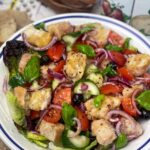
Italian Bread Salad [Panzanella]
Equipment
- Baking tray [optional] with parchment paper [baking paper] to line tray if necessary
- Large salad bowl or similar
- Small mixing bowls
Ingredients
Bread chunks:
- 300 grams crusty bread any variety, use gluten-free if required [sliced or torn into bite-sized chunks]
- 2 tablespoon red wine vinegar [or balsamic vinegar]
Quick pickled red onion:
- 100 grams sliced red onion sliced into thin strips [1 medium onion]
- 1 tablespoon red wine vinegar [or balsamic vinegar]
- 2 teaspoon sugar granulated or your usual sugar or syrup such as maple, agave, rice, date
Salad:
- 200 grams cucumber sliced into thick bite-size chunks
- 150 grams tomatoes if using cherry tomatoes half them or if larger tomatoes slice into bite-size chunks
- 150 grams lettuce any variety, sliced if large leaves, baby leaves can be left whole
Salad dressing:
- 4 tablespoon olive oil
- 1 tablespoon red wine vinegar [or balsamic vinegar]
- 2 teaspoons sugar
Optional:
- olives [use whatever amount you prefer]
- 1 bunch fresh basil [use however much basil you prefer]
Instructions
Toasting the bread: [optional, can simply use the bread untoasted]
- Preheat the oven to 180 Fan, 200C, 392 Fahrenheit, Gas 6.
- Slice or rip the bread into bitesize pieces and add to a bowl. Sprinkle the red wine vinegar over the bread and toss the bread around to coat in the vinegar. If you don't mind using your hands, then stir the bread cubes around and against the sides with your hands so that they soak up all the vinegar.300 grams crusty bread, 2 tablespoon red wine vinegar
- Place the bread cubes onto a baking tray, lined with baking paper if necessary, and bake on the middle oven shelf for 5 minutes. Turn the bread around and toast for a further 5 minutes. Set aside to cool while you prepare the rest of the salad.
Prepare the quick pickled red onion:
- Add the thin slices of onion to a small bowl and add the red wine vinegar and sugar. Give the onions a good mix so that they are all equally coated in the mixture. Set aside to pickle while the rest of the salad is prepared.100 grams sliced red onion, 1 tablespoon red wine vinegar, 2 teaspoon sugar
Prepare the easy salad dressing:
- Add the red wine vinegar, sugar, and olive oil to a small bowl. Season with a pinch of salt and some black pepper. Stir well.4 tablespoon olive oil, 1 tablespoon red wine vinegar, 2 teaspoons sugar
Assemble the Panzanella:
- Add the lettuce, tomatoes, and cucumber to a large salad bowl. Next add the bread pieces, and olives if using.Add most of the basil leaves and the pickled red onion keeping some of them back to sprinkle over the top. Season with enough salt and pepper to bring all the flavours together, the exact amount is personal preference as some people may not like any salt or pepper.Drizzle over the salad dressing and give everything a good mix so that all the dressing, salad and bread are completely combined.200 grams cucumber, 150 grams tomatoes, 150 grams lettuce, olives, 1 bunch fresh basil
- Sprinkle over the remaining basil leaves and pickled red onions and now the Panzanella is good to go. Enjoy!
Notes
- Nutritional data is for guidance only and is not a strict calculation as ingredients vary.
- For 6 smaller portions the estimated nutritional value is: 261Kcal, 32g Carbs, 7g protein, 12g fat, 3mg iron, 694 IU Vitamin A, 53mg Calcium and 3g fibre.
- Increase the fibre content by using wholemeal or whole wheat bread.
- Store leftovers for 1-2 days, Panzanella is at its freshest once made and the bread will soak up the dressing and become softer as it sits, but those soggy bits are actually very tasty.
- If meal prepping the salad in advance, store all the components separately before combining together when ready to serve.
- Stale bread is perfect for using up in this tasty bread salad, but of course fresh bread will work just as well.
- French baguettes are particularly tasty for a Panzanella salad.
- Toasting the bread is an optional step and can be omitted.
- For a gluten-free bread salad choose a gluten-free bread.
- Olives are optional and can be simply omitted or replaced with a few broken walnuts, sunflower seeds, pumpkin seeds, capers, more tomatoes, or even some juicy grapes.
- On an oil-free diet? Replace the oil with a light tahini. If your tahini is really thick, whip it with a fork to loosen it up.
- Do check out our recipe notes and FAQ section above the recipe for more substitution ideas, as well as an easy method for using the air-fryer to toast bread cubes, and for other helpful information so that you can devise the best vegan Panzanella salad ever!
Nutrition
Thank you for trying out our Easy Panzanella Bread Salad ! We hope you enjoyed making and eating it as much as we do.
If you tried this recipe, please let us know in the comments below how it turned out for you, or if you made any modifications.
If you share your creations on social media, don't forget to tag us (@traditionalplantbasedcooking) and use the hashtag #traditionalplantbasedcooking, so we can see your delicious dishes!
Lastly, if you found this recipe helpful, please share it with your friends and family, so they can enjoy it too.
As always, Thank you, and happy cooking!
Love, Jacq x
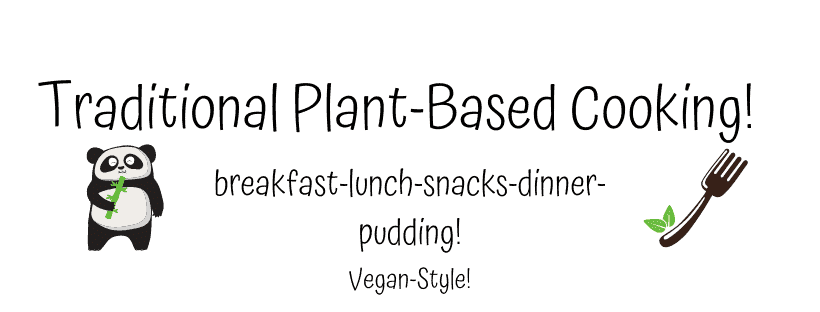

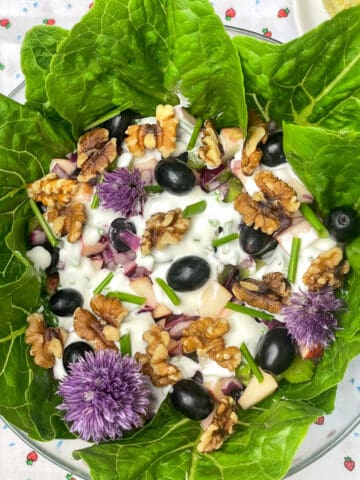
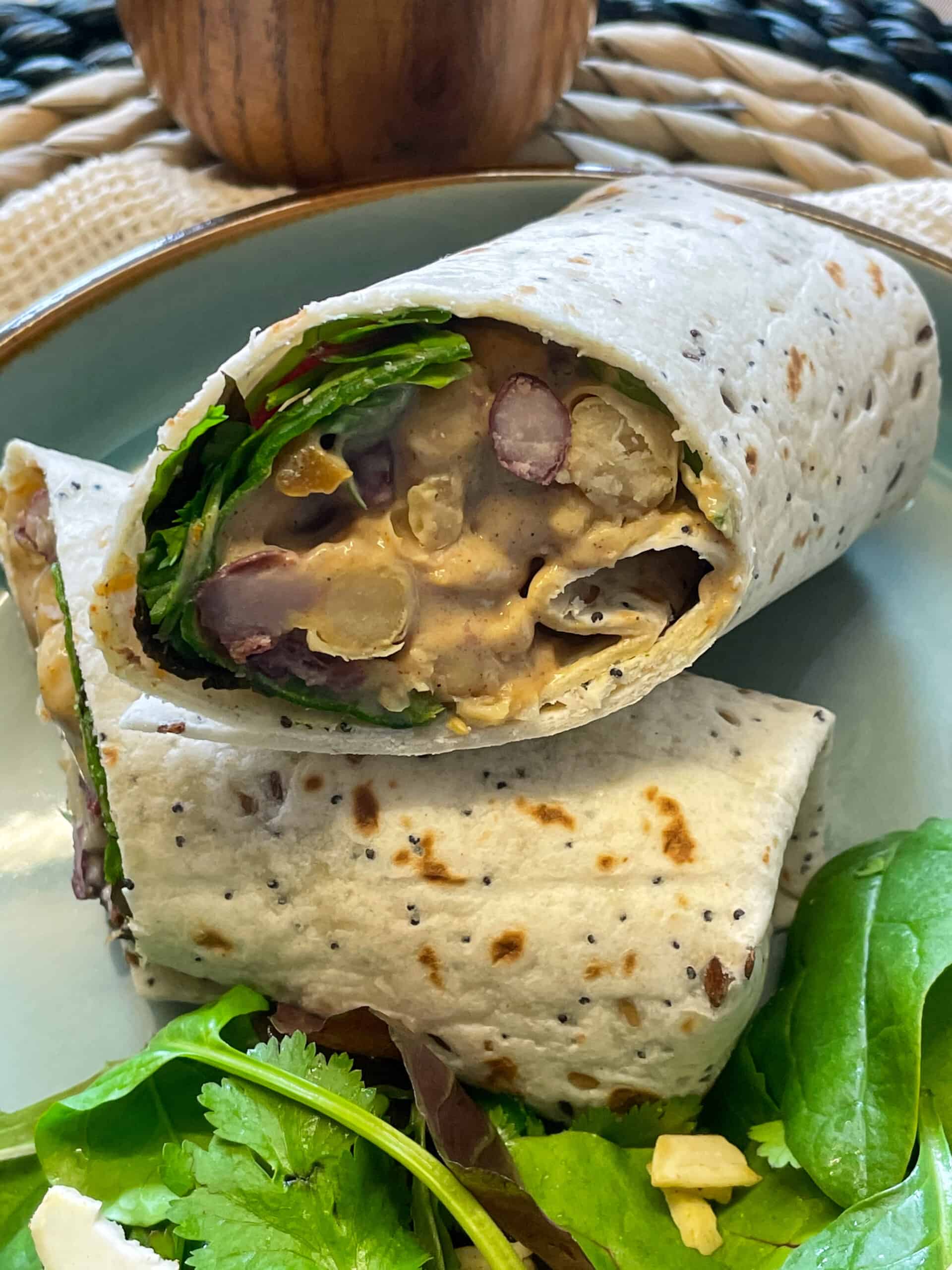
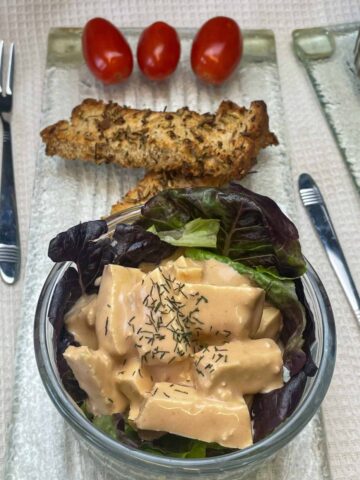
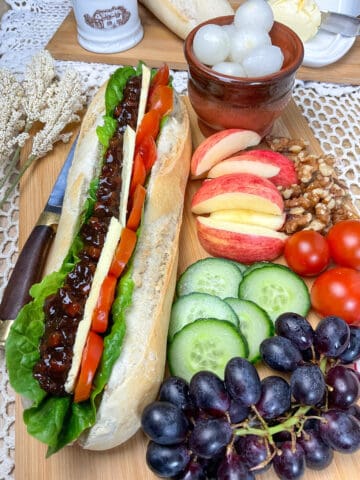
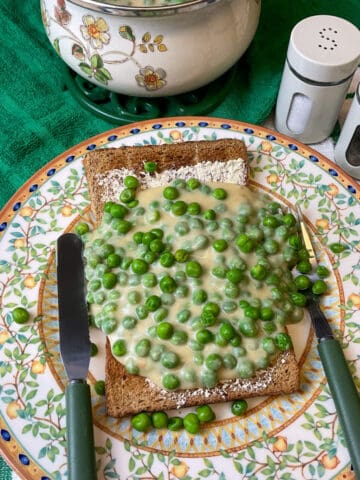
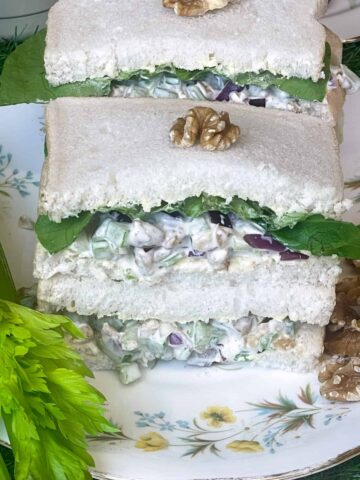
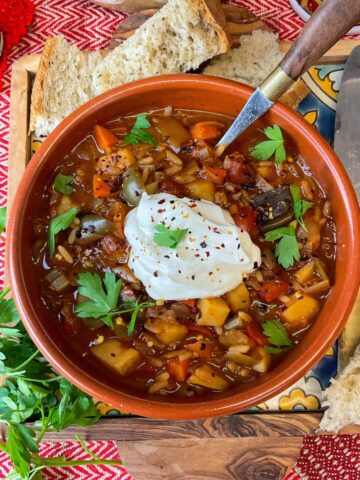

Leave a Reply